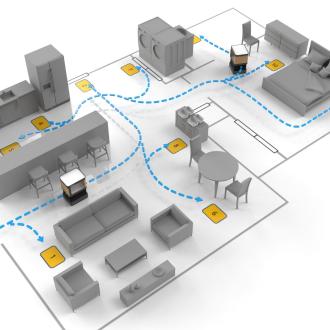California-based tech company Labrador Systems has debuted an autonomous personal robot that can carry items between different parts of the home — easing the burden on people with mobility issues and helping them live more independently.
The challenge: For people with mobility issues, moving things from one part of the house to another can be challenging, if not impossible.
Just consider trying to carry a plate of food from the kitchen to the dining room table while using a walker, or a hamper full of clothes from your bedroom to the washing machine after a stroke has paralyzed one of your arms.
These challenges can greatly impact a person’s quality of life and even prevent them from being able to live independently.
“It’s like having a second person in the house. It helps that much.”
Janet
The idea: Labrador has developed a deceptively simple personal robot to solve this problem.
Named the Labrador Retriever (ba-dum, tss), the robot looks like your basic end table, but you can put whatever you want on top of it and then tell the robot where to go in your home using either a touchscreen or voice commands.
“Using a Labrador provides me a lot of independence, whether it’s setting the table or getting laundry into the washing machine,” pilot user Janet, who was diagnosed with multiple sclerosis 10 years ago, said. “I’m not lifting anything, I’m not having to bend over. I’m not at risk of falling.”
“It’s providing me with the ability to do tasks that normally I would have to ask for help with,” she continued. “It’s like having a second person in the house. It helps that much.”
How it works: The first step to using the Retriever is programming it to navigate between “bus stops” in your home — these are the places that you know you’ll want the robot to go, such as beside the washing machine or next to the refrigerator.
The robot can then use its system of sensors and AI algorithms to move between the stops on command.
In addition to lugging around whatever you place on top of it (up to 25 pounds), Labrador’s personal robot can also retrieve items for you, as long as they’re placed on one of the bot’s accompanying trays at a bus stop.
This takes a little planning, but could have a number of uses — a caregiver could set up a tray with a person’s medications in the morning, for example, and the robot could then bring the tray to them when it’s time to take the pills.
The cost: Labrador is currently accepting refundable deposits of $250 for Retrievers. Users will have to pay the rest of a $1,500 upfront cost when they receive the personal robot, plus $149 per month for 36 months after, bringing its total cost to about $6,800.
Labrador is also accepting deposits for a less-advanced $5,000 version of the robot called the “Caddie” — it lacks the ability to retrieve trays and has a set height while the Retriever’s is adjustable.

After the 36 months, users will own the robots outright, but they’ll need to pay Labrador for new feature support or an extended warranty (that cost hasn’t yet been disclosed).
The company expects to be in full production on the robots by the second half of 2023, but says beta test units will be available sooner.
The big picture: Labrador’s personal robot already has a large potential user base — more than 18 million people in the U.S. and Canada have mobility issues due to injuries, disease, or old age.
It could be even bigger in the future, though, as experts predict that 20% of the global population will be over the age of 60 in 2050, compared to just 12% now.
Personal robots like the Retriever could make it easier for those seniors to live independently longer, simultaneously improving their quality of life while reducing the demand for caregivers.
We’d love to hear from you! If you have a comment about this article or if you have a tip for a future Freethink story, please email us at [email protected].






